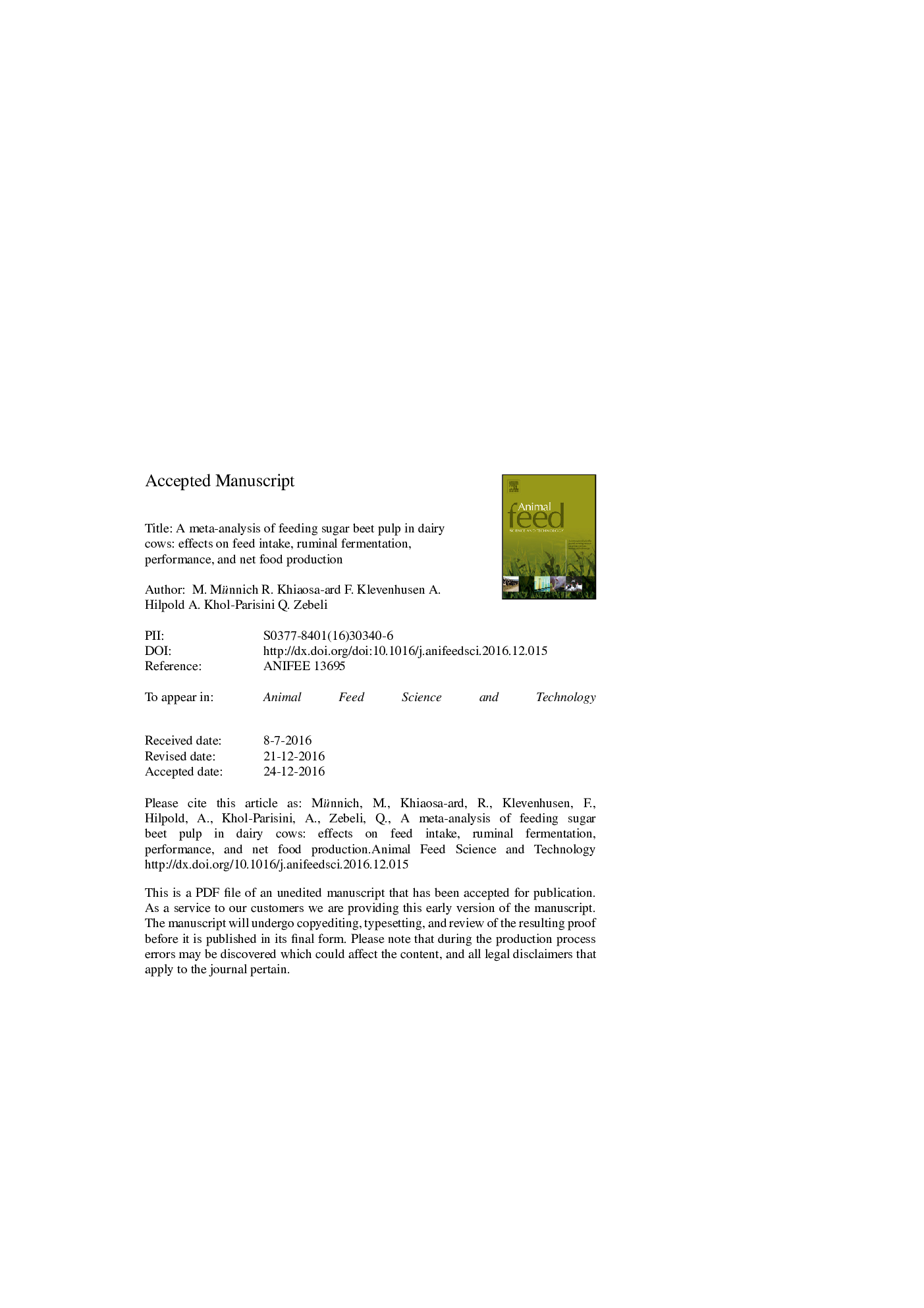| کد مقاله | کد نشریه | سال انتشار | مقاله انگلیسی | نسخه تمام متن |
|---|---|---|---|---|
| 5538781 | 1552362 | 2017 | 43 صفحه PDF | دانلود رایگان |
عنوان انگلیسی مقاله ISI
A meta-analysis of feeding sugar beet pulp in dairy cows: Effects on feed intake, ruminal fermentation, performance, and net food production
ترجمه فارسی عنوان
یک متاآنالیز پالپ چغندر قند در گاوهای شیری: تأثیر بر مصرف غذا، تخمیر شوری، عملکرد و تولید مواد غذایی خالص
دانلود مقاله + سفارش ترجمه
دانلود مقاله ISI انگلیسی
رایگان برای ایرانیان
کلمات کلیدی
موضوعات مرتبط
علوم زیستی و بیوفناوری
علوم کشاورزی و بیولوژیک
علوم دامی و جانورشناسی
چکیده انگلیسی
Feeding of industrial by-products such as sugar beet pulp (Bp) is an economically viable option in dairy production, but high inclusion rates might impair feed intake and performance of the cows. The present meta-analysis was performed to evaluate inclusion of Bp in dairy cow diets taking into account inclusion rate of Bp, feed intake and production levels of the cows, concentrate level in the diet and replacement aim of Bp (i.e., grain type and forage replaced). Effects on dry matter intake (DMI), ruminal fermentation, and milk production variables as well as on net food production, as a measure of sustainability, were determined using meta-analysis and meta-regression approaches. Data were extracted from 34 different studies published from 1990 to 2016, comprising a total of 103 dietary treatments. The effect of Bp on DMI depended largely (P = 0.016) on the feed intake level of cows. DMI decreased with increasing Bp inclusion level in cows with a high feed intake level (>3.5% of BW), but not in cows with a low intake level (â¤3.5% of BW), noted by an interaction between Bp level and feed intake level (P = 0.015). Bp inclusion had no effect on milk yield (P = 0.514) but increased milk fat yield (P = 0.004) and fat-corrected milk yield (P = 0.002). Effects of Bp on milk production variables were independent of the dietary concentrate level as well as the replacement aim. Ruminal pH increased (P = 0.046) but only when Bp was fed at a level of >200 g/kg of diet DM. There were interactions between the Bp inclusion and the dietary concentrate level for molar percentages of propionate (P = 0.008) and butyrate (P = 0.021) and, to a lesser extent, for acetate (P = 0.057), with acetate and propionate being altered by Bp only in high concentrate diets. All variables related to net food production including kg milk/MJ human edible energy input (P = 0.002) or g milk protein/g human edible protein input (P = 0.027) were strongly improved by feeding of Bp. In conclusion, the effect of Bp as a feedstuff for dairy cows depends on the cow's feed intake and production level, whereby high inclusion rates of Bp seem to be particularly beneficial in cows in which the feed intake level does not exceed 3.5% of BW.
ناشر
Database: Elsevier - ScienceDirect (ساینس دایرکت)
Journal: Animal Feed Science and Technology - Volume 224, February 2017, Pages 78-89
Journal: Animal Feed Science and Technology - Volume 224, February 2017, Pages 78-89
نویسندگان
M. Münnich, R. Khiaosa-ard, F. Klevenhusen, A. Hilpold, A. Khol-Parisini, Q. Zebeli,
